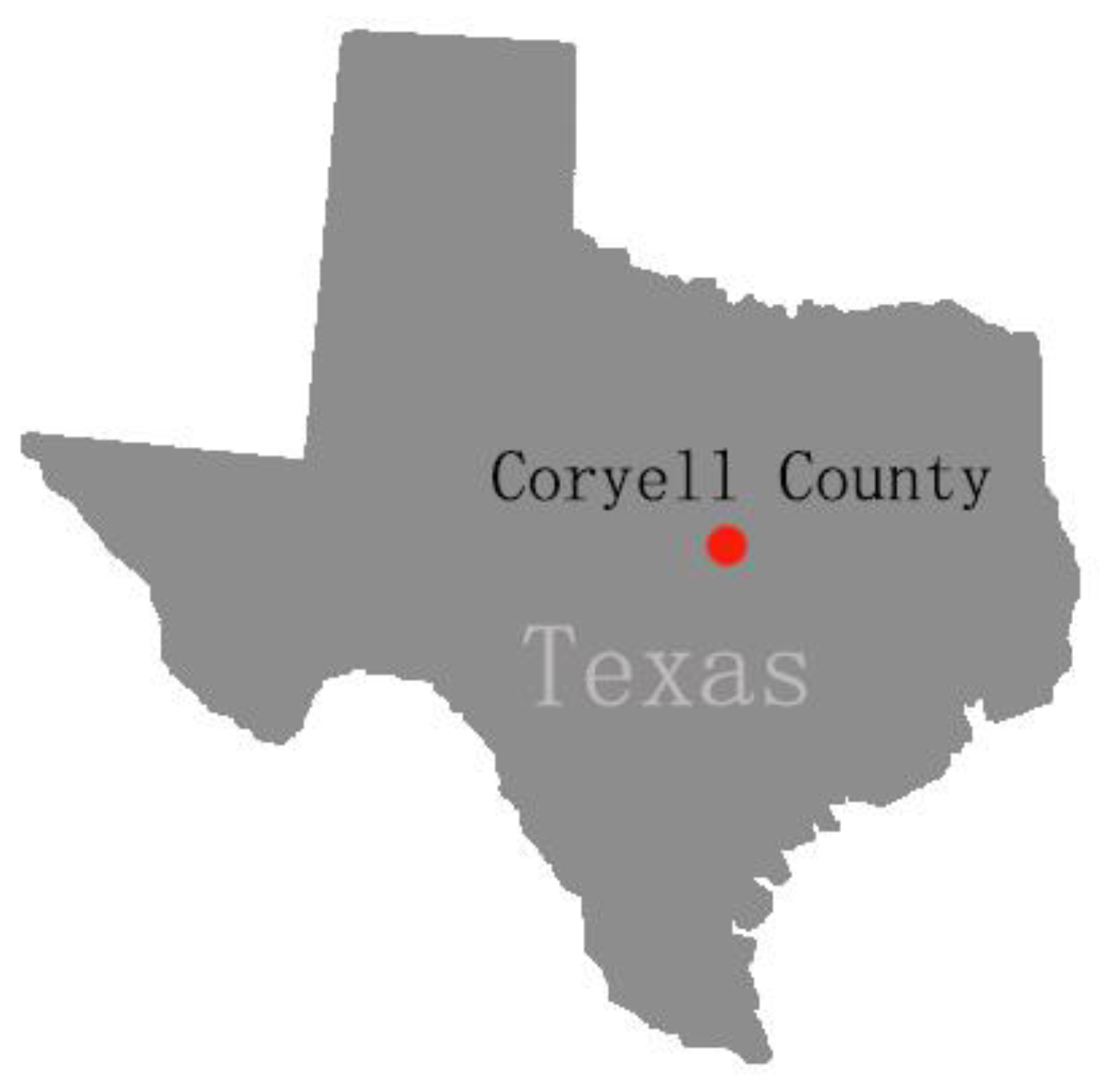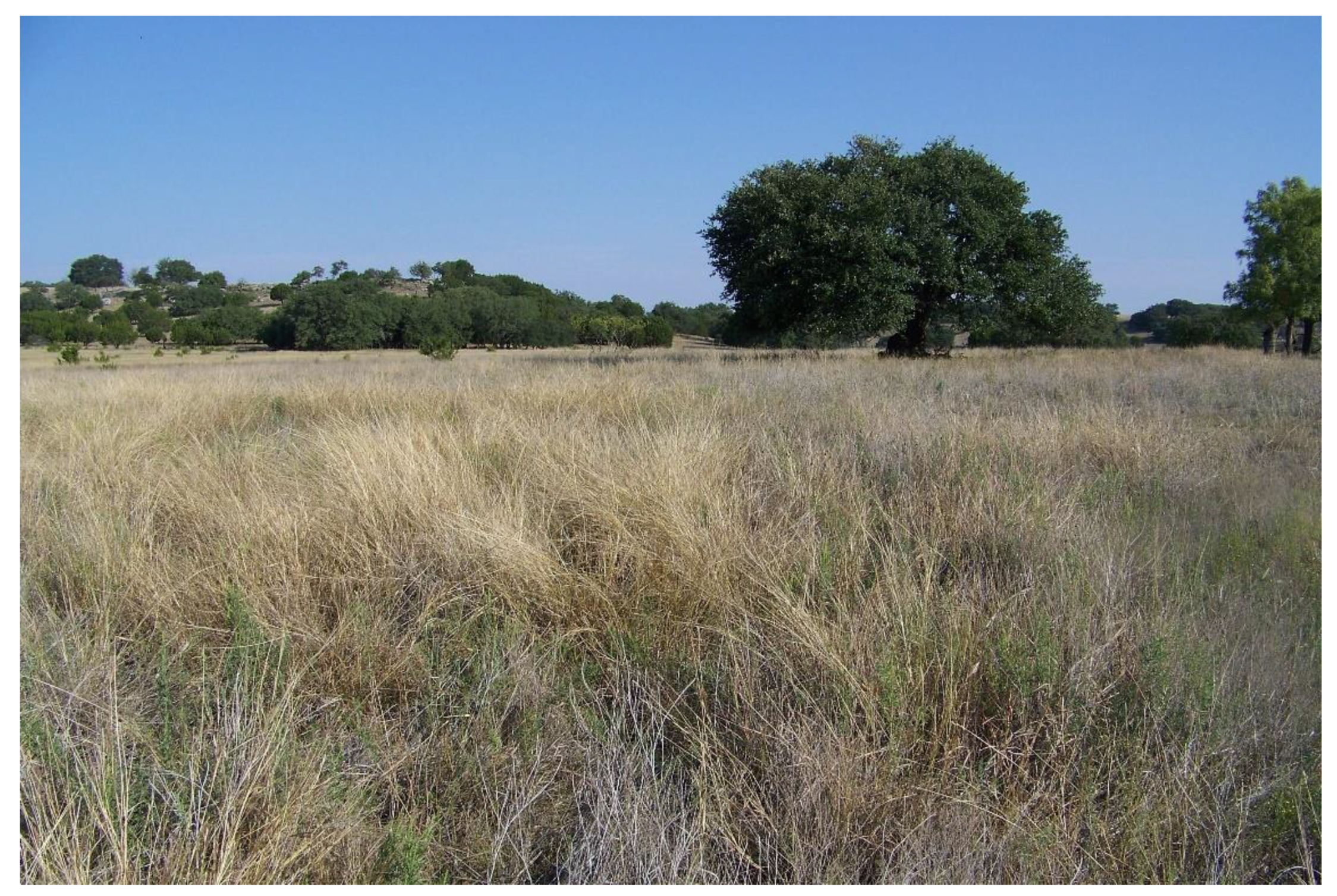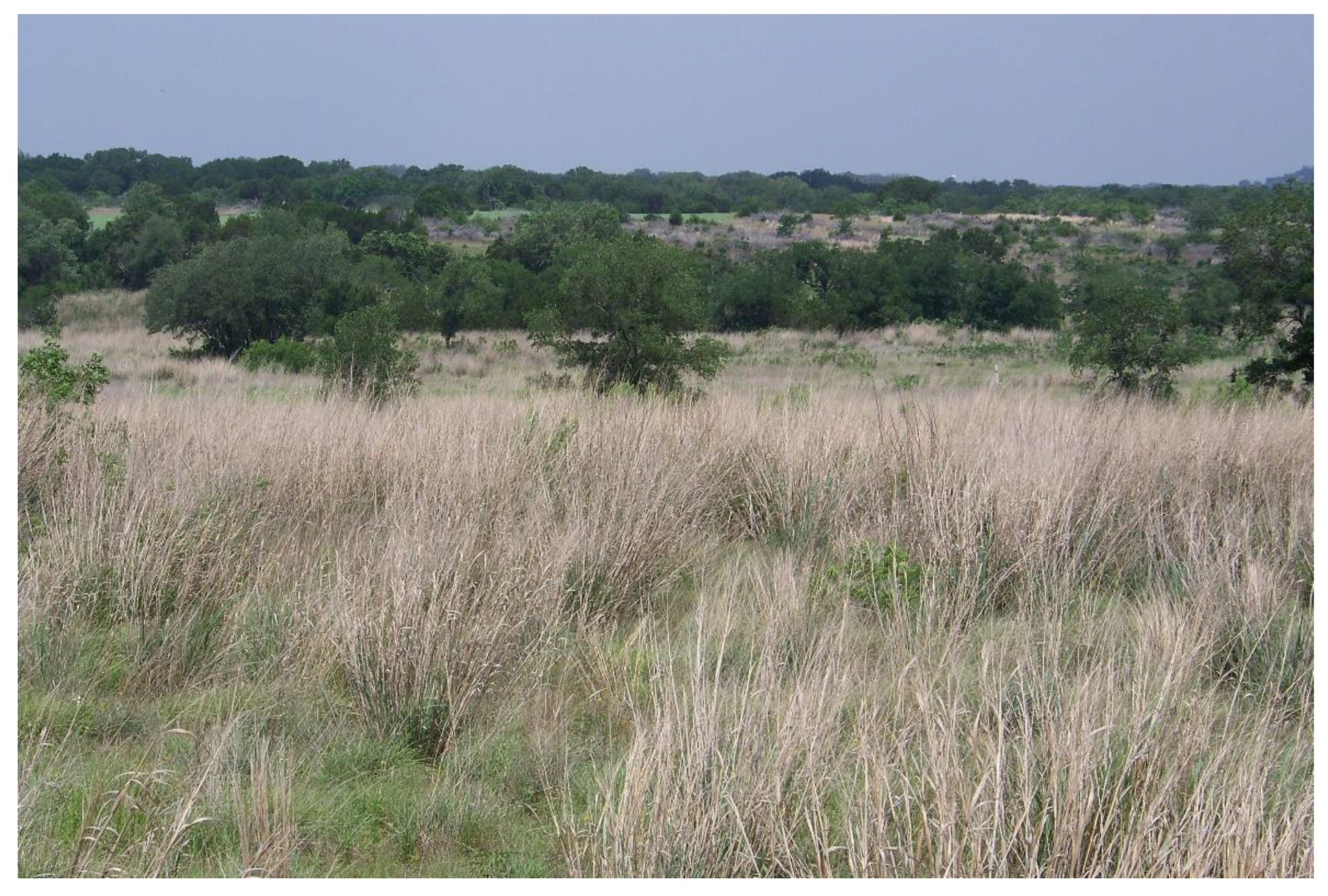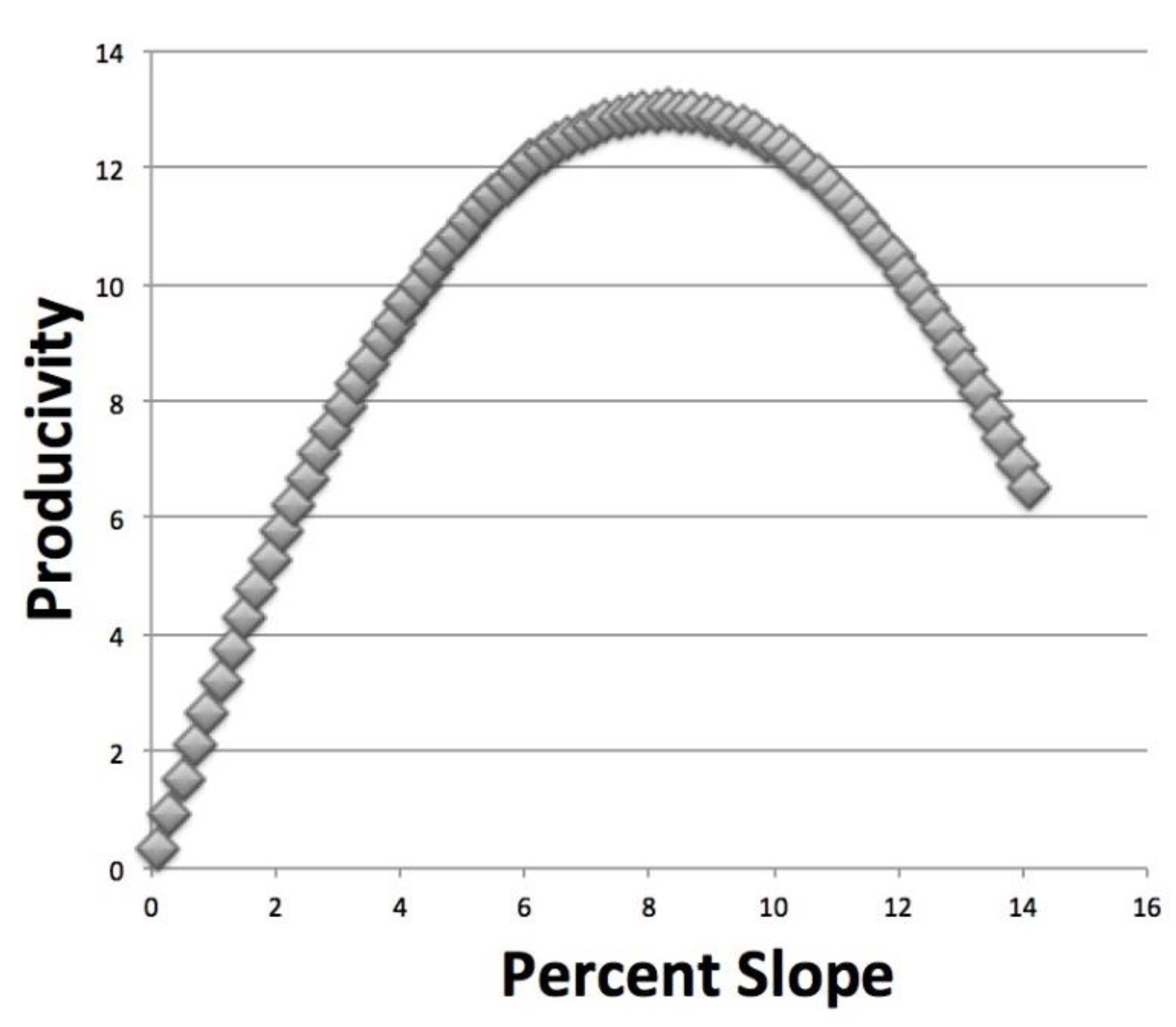Soil-Based Vegetation Productivity Model for Coryell County, Texas
Abstract
1. Introduction
2. Materials and Methods
2.1. Coryell County Study Area
2.2. Statistical Analysis
3. Results
- VP = vegetation productivity of the soil
- SL = percent slope
- AW = available water holding capacity
- HC = hydraulic conductivity
- OM = percent organic matter
- EC = electrical conductivity
4. Discussion
- Modest slopes assist productivity;
- Maximizing available water hold capacity is beneficial;
- Quick internal drainage (hydraulic conductivity) of slopes is not beneficial;
- Organic matter in the soil increases productivity unless the available water holding capacity is already high;
- Increased organic matter tempers soil electric conductivity (salty soils).
Author Contributions
Funding
Acknowledgments
Conflicts of Interest
Appendix A
| Variable | Mean | Standard Deviation | Minimum | Maximum |
|---|---|---|---|---|
| % Clay | 24.20 | 10.01 | 3.30 | 52.23 |
| Bulk Density | 1.38 | 0.07 | 1.23 | 1.56 |
| % Organic Matter | 0.96 | 0.38 | 0.42 | 2.20 |
| Available Water Holding | 0.15 | 0.03 | 0.04 | 0.19 |
| % Rock Fragments | 0.52 | 1.13 | 0.00 | 8.00 |
| Hydraulic Conductivity | 2.26 | 3.08 | 0.04 | 17.87 |
| Soil Reaction | 7.93 | 0.29 | 7.37 | 8.74 |
| Electrical Conductivity | 1.81 | 1.90 | 0.00 | 9.18 |
| % Slope | 3.28 | 3.57 | 1.00 | 24.50 |
| Topographic Position | 1.17 | 0.59 | 0.50 | 4.00 |
References
- Burley, J.B. Vegetation productivity equation compatibility with selected state environmental reclamation laws and regulations. In International Land Reclamation and Mine Drainage Conference and the Third International Conference on the Abatement of Acidic Drainage: Volume 4 of 4: Abandoned Mined Lands and Topical Issues; Bureau of Mines Special Publication SP 06D-94; United States Department of the Interior: Pittsburgh, PA, USA, 1994; pp. 294–303. [Google Scholar]
- Burley, J.B. Vegetation productivity equations: An overview. In Proceedings of the 1992 National Symposium on Prime Farmland Reclamation; Dunker, R.E., Barnhisel, R.I., Darmody, R.G., Eds.; Department of Agronomy, University of Illinois: Urbana, IL, USA, 1992; pp. 259–265. [Google Scholar]
- Burley, J.B.; Thomsen, C.H. Multivariate techniques to develop vegetation productivity models for neo-sols. In Proceedings of the 1987 Symposium on Surface Mining, Hydrology, Sedimentology and Reclamation; University of Kentucky: Lexington, KY, USA, 1987; pp. 153–161. [Google Scholar]
- Burley, J.B. Methodology for building soil based vegetation productivity equations: A statistical approach. In Proceedings of the Thirteenth Annual Meeting American Society for Surface Mining and Reclamation: Successes and Failures: Applying Research Results to Insure Reclamation Success, Knoxville, TN, USA, 18–23 May 1996; Daniels, W.L., Burger, J., Zipper, C.E., Eds.; Virginia Tech Research Division, Powell River Project: Blacksburg, VA, USA, 1996; pp. 789–798. [Google Scholar]
- Roecher, S.; Thomas, P.; Beaudette, D.; Willis, K. Looking Back: The History of Soil Survey Thru Metrics; North Central Cooperative Soil Survey Workshop: Brookings, SD, USA, 2018. Available online: https://www.researchgate.net/publication/328890443_Looking_Back_The_History_of_Soil_Survey_Thru_Metrics (accessed on 2 June 2020).
- Soil Survey Division Staff; United States Department of Agriculture. Soil Survey Manual. United States; Handbook No. 18; Department of Agriculture: Washington, DC, USA, 1993.
- Kendall, M.G. The Geographical Distribution of Crop Productivity in England. J. R. Stat. Soc. 1939, 102, 21–48. [Google Scholar] [CrossRef]
- Jeanne, T.; Parent, S.-É.; Hogue, R. Using a soil bacterial species balance index to estimate potato crop productivity. PLoS ONE 2019, 14, e0214089. [Google Scholar] [CrossRef]
- Zak, J.; Willig, M.; Moorhead, D.; Wildman, H. Functional diversity of microbial communities: A quantitative approach. Soil Boil. Biochem. 1994, 26, 1101–1108. [Google Scholar] [CrossRef]
- Natural Resource Conservation Service. Annual Data Refresh of Soil Survey Data; United States Department of Agriculture, Natural Resource Conservation Service: Washington, DC, USA, 2018. Available online: http://nrcs.usda.gov (accessed on 2 June 2020).
- Burley, J.B.; Thomsen, C.H.; Kenkel, K. Development of an agricultural productivity model to reclaim surface mines in Clay County, Minnesota. Environ. Manag. 1989, 13, 63–638. [Google Scholar]
- Burley, J.; Thomsen, C.H. Application of an agricultural soil productivity equation for reclaiming surface mines: Clay County, Minnesota. Int. J. Surf. Min. Reclam. Environ. 1990, 4, 139–144. [Google Scholar] [CrossRef]
- Burley, J.B. A vegetation productivity equation for reclaiming surface mines in Clay County, Minnesota. Int. J. Surf. Min. Reclam. Environ. 1991, 5, 1–6. [Google Scholar] [CrossRef]
- Burley, J.B. Sugarbeet Productivity Model for Clay County Minnesota. J. Sugarbeet Res. 1990, 27, 50–59. [Google Scholar] [CrossRef]
- Burley, J.B.; Bauer, A. Neo-sol Vegetation Productivity Equations for Reclaiming Disturbed Landscapes: Central Florida Example. J. Am. Soc. Min. Reclam. 1993, 1993, 334–347. [Google Scholar] [CrossRef]
- Burley, J.B. A multi-county vegetation productivity equation for soil reclamation. In Proceedings of Sudbury’95-Mining and the Environment; Hynes, T.P., Blanchette, M.C., Eds.; CANMET: Ottawa, ON, Canada, 1995; Volume 3, pp. 1113–1122. [Google Scholar]
- Burley, J.B.; Polakowski, K.J.; Fowler, G. Constructing vegetation productivity equations by employing undisturbed soils data: An Oliver County, North Dakota case study. In Proceedings of the Thirteenth Annual Meeting American Society for Surface Mining and Reclamation: Successes and Failures: Applying Research Results to Insure Reclamation Success, Knoxville, TN, USA, 18–23 May 1996; Daniels, W.L., Burger, J., Zipper, C.E., Eds.; Virginia Tech Research Division, Powell River Project: Blacksburg, VA, USA, 1996; pp. 393–401. [Google Scholar]
- Burley, J.B.; Fowler, G.W.; Polakowski, K.; Brown, T.J. Soil Based Vegetation Productivity Model for the North Dakota Coal Mining Region. Int. J. Surf. Min. Reclam. Environ. 2001, 15, 213–234. [Google Scholar] [CrossRef]
- Burley, J. A spatial application of a vegetation productivity equation for neo-sol reconstruction. J. Am. Soc. Min. Reclam. 1999, 1999, 708–714. [Google Scholar] [CrossRef]
- Burley, J.B.; Gray, D. Soil ordination: Implications for post-mining disturbance land-uses. J. Am. Soc. Min. Reclam. 2001, 2001, 241–245. [Google Scholar] [CrossRef]
- Burley, J.B. Environmental Design for Reclaiming Surface Mines; Edwin Mellen Press: Lewiston, NY, USA, 2001. [Google Scholar]
- Le Cleac’h, G.; Salles, G.M.; Burley, J.B. Vegetation productivity model for Grand Traverse County. In Michigan. 21st National Meeting of the American Society of Mining and Reclamation and The 25th West Virginia Surface Mine Drainage Task Force. Morgantown, WV, USA, 18–24 April 2004; ASMR: Lexington, KY, USA, 2004; pp. 1176–1191. [Google Scholar]
- Chang, Q.; Bai, Y.; Burley, J.B.; Partin, S. Soil-based vegetation productivity model for mined lands in Chippewa County, Wisconsin. In Recent Advances in Environment, ecosystems and Development, Proceedings of the 13th International Conference on Environment, Ecosystems and Development (EED’15), Kuala Lumpur, Malaysia, 23–25 April 2015; Bulucea, A., Ed.; Energy, Environmental and Structural Engineering Series|35; World Scientific and Engineering Academy and Society: Athens, Greece, 2015; pp. 15–22. [Google Scholar]
- Bai, Y.; Chang, Q.; Guo, C.; Burley, J.B.; Partin, S. Neo-sol productivity models for disturbed lands in Wisconsin and Georgia, USA. Int. J. Energy Environ. 2016, 10, 52–60. [Google Scholar]
- Burley, J.B.; Wu, Z.; He, S.; Li, X. Soil-based vegetation productivity models for disturbed lands along the north and central western Great Plains, USA. J. Adv. Agric. Technol. 2020. in publication. [Google Scholar]
- Burley, J.B.; Machemer, T. From Eye to Heart: Exterior Spaces Explored and Explained; Cognella Academic Publishing: San Diego, CA, USA, 2016. [Google Scholar]
- Humphries, R.N.; Thompson, R.J.K.; Heames, M.D. Case study: Appraisal of four soil-based metrics in the establishment of sustainable upland grassland at a mine site in south wales, united kingdom. J. Am. Soc. Min. Reclam. 2019, 2019, 1–21. [Google Scholar] [CrossRef]
- Burley, J.B.; Li, X.; He, S. Metrics Evaluating Multivariate Design Alternatives: Application of the Friedman’s Two-way Analysis of Variance by Ranks: A Personal Reflection; Whitemud Academics: Perrinton, MI, USA, 2020; p. 36. [Google Scholar]
- Burley, J.B.; Li, N.; Ying, J.; Tian, H.; Troost, S. Chapter 3: Metrics in master planning low impact development for Grand Rapids, Michigan. In Sustainable Urbanization; Egren, M., Ed.; Intech: Rijeka, Croatia, 2016; pp. 61–86. [Google Scholar]
- Duan, X.-W.; Han, X.; Hu, J.-M.; Feng, D.-T.; Rong, L. A novel model to assess soil productivity in the dry-hot valleys of China. J. Mt. Sci. 2017, 14, 705–715. [Google Scholar] [CrossRef]
- Rodrique, J.A.; Burger, J.A. Forest soil productivity of mined land in the midwestern and eastern coalfield regions. Soil Sci. Soc. Am. J. 2004, 68, 833–844. [Google Scholar] [CrossRef]
- Barnhisel, R.I.; Hower, J.M. The use of productivity index to predict corn yields of restored prime farmland. In International Land Reclamation and Mine Drainage Conference and the Third International Conference on the Abatement of Acidic Drainage: Volume 3 of 4: Vegetation and Reclamation; Bureau of Mines Special Publication SP 06D-94; United States Department of the Interior: Pittsburgh, PA, USA, 1994; pp. 20–27. [Google Scholar]
- Peng, L.; Zhanbin, L.; Zhang, Z. An index system and method for soil productivity evaluation on the hillsides on the Loess Plateau. In 12th ISCO Conference; Tsinghua University Press: Beijing, China, 2002. [Google Scholar]
- Dyson, F. Disturbing the Universe; Basic Books; Sloan Foundation Science Series Edition: New York, NY USA, 1981. [Google Scholar]
- Burras, C.L.; Miller, G.A.; Fenton, T.E.; Sassman, A.M. Corn Suitability Rating 2 (CSR2) Equation and Component Values; Iowa State University: Ames, IA, USA, 2015. [Google Scholar]
- Schaetzl, R.J.; Krist, F.J., Jr.; Miller, B.A. A taxonomically based ordinal estimate of soil productivity for landscape-scale analysis. Soil Sci. 2012, 177, 28–299. [Google Scholar] [CrossRef]
- Voltr, V. Concept of soil fertility and soil productivity: Evaluation of agricultural sites in the Czech Republic. Arch. Agron. Soil Sci. 2012, 58, S243–S251. [Google Scholar] [CrossRef]
- McCaleb, N. Soil Survey of Coryell County, Texas; United States Department of Agriculture, Soil Conservation Service: Washington, DC, USA, 1985.
- Guretzky, J.A.; Anderson, A.B.; Fehmi, J.S. Grazing and Military Vehicle Effects on Grassland Soils and Vegetation. Gt. Plains Res. J. Nat. Soc. Sci. 2006, 16, 51–61. [Google Scholar]
- Hatter, M.D.; Morgan, D.L. Growth and visual responses of three Southwestern Acer taxa to high-salt irrigation water. J. Environ. Hortic. 1992, 10, 118–120. [Google Scholar]
- Anderson, A.B.; Wang, G.; Fang, S.; Gertner, G.Z.; Güneralp, B.; Jones, D. Assessing and predicting changes in vegetation cover associated with military land use activities using field monitoring data at Fort Hood, Texas. J. Terramech. 2005, 42, 207–229. [Google Scholar] [CrossRef]
- Burley, J.B. Constructing Interpretable Environments from Multidimensional Data: GIS Suitability Overlays and Principal Component Analysis. J. Environ. Plan. Manag. 1995, 38, 537–550. [Google Scholar] [CrossRef]
- Burley, J.B.; Singhal, V.B.P.; Burley, C.J.; Fasser, D.; Churchward, C.; Hellekson, D.; Raharizafy, I. Citation Analysis of Transportation Research Literature: A Multi-Dimensional Map of the Roadside Universe. Landsc. Res. 2009, 34, 481–495. [Google Scholar] [CrossRef]
- Gellar, D.; Bauer, A.; Burley, J.B. Mapping the reclamation regulation universe in the United States and Canada: A 1994/95 topology experience. In Sudbury’99 Mining and the Environment II: An Integrated Approach to Planning and Rehabilitation for the Future, Sudbury, ON, Canada, 13–17 September 1999; Goldsack, D., Belizile, N., Yearwood, P., Hall, G., Eds.; Laurentian University: Sudbury, ON, Canada, 1999; Volume 3, pp. 991–1000. [Google Scholar]
- Qi, J.; Wang, S.; Burley, J.B.; Machemer, T. Defining ecological regions in Michigan based on native tree distributions. Landsc. Archit. 2012, 6, 138–145, (translated by Wang, S.). [Google Scholar]
- Xu, Y.; Burley, J.B.; Machemer, R.; Allen, A. A dimensional comparison between classical Chinese gardens and modern Chinese gardens. WSEAS Trans. Environ. Dev. 2016, 12, 200–213. [Google Scholar]
- Xu, H.; Burley, J.B.; Crawford, P.; Schutzki, R. Cross-cultural ordination of burial sites. Int. J. Cult. Herit. 2017, 2, 92–104. [Google Scholar]
- Xu, H.; Burley, J.B.; Crawford, P.; Wang, Y.; Yue, Z.; Schutzki, R. An ordination of western and Chinese burial sites. WSEAS Trans. Environ. Dev. 2017, 13, 452–469. [Google Scholar]
- Burley, J.B. The Emergence of Landscape Urbanism: A Chronological Criticism Essay. Land 2018, 7, 147. [Google Scholar] [CrossRef]
- Marsh, G.P. Man and Nature: Physical Geography as Modified by Human Action; Scribner, C.: New York, NY, USA, 1864. [Google Scholar]




| Eigenvalues of the Covariance Matrix | ||||
|---|---|---|---|---|
| Principal Component | Eigenvalue | Difference | Proportion | Cumulative |
| 1 | 4.97386662 | 4.58907869 | 0.8290 | 0.8290 |
| 2 | 0.38478793 | 0.08866757 | 0.0641 | 0.8931 |
| 3 | 0.29612037 | 0.09889705 | 0.0494 | 0.9425 |
| 4 | 0.19722332 | 0.08873028 | 0.0329 | 0.9753 |
| 5 | 0.10849304 | 0.06898432 | 0.0181 | 0.9934 |
| 6 | 0.03950872 | 0.0066 | 1.0000 | |
| Eigenvectors | ||||||
|---|---|---|---|---|---|---|
| Prin1 | Prin2 | Prin3 | Prin4 | Prin5 | Prin6 | |
| WHEAT | 0.403243 | −0.051705 | −0.706695 | −0.261811 | 0.514348 | 0.046954 |
| OATS | 0.430054 | −0.119093 | −0.137170 | −0.193362 | −0.684043 | 0.526072 |
| GRAIN SORGHUM | 0.436191 | −0.188980 | 0.045913 | −0.135658 | −0.292321 | −0.817351 |
| COTTON LINT | 0.401516 | −0.214618 | 0.682568 | −0.336950 | 0.410664 | 0.211291 |
| BERMUDAGRASS | 0.407866 | −0.236953 | 0.018009 | 0.869526 | 0.115754 | 0.087745 |
| POTENTIAL ANNUAL PRODUCTION | 0.366902 | 0.919360 | 0.115907 | 0.077793 | 0.005929 | −0.025284 |
| Variable | Parameter Estimate | Standard Error | Type II SS | F Value | Pr > F |
|---|---|---|---|---|---|
| Intercept | −11.15 | 1.76 | 12.28 | 39.98 | < 0.0001 |
| SL | 3.24 | 0.08 | 4.94 | 16.10 | 0.0009 |
| AW | 103.63 | 11.12 | 26.66 | 86.83 | < 0.0001 |
| SL2 | −0.19 | 0.04 | 3.30 | 10.74 | 0.0044 |
| SLHC | −0.13 | 0.05 | 2.36 | 7.70 | 0.0130 |
| SLAW | −25.52 | 4.23 | 11.18 | 36.41 | < 0.0001 |
| AWOM | −12.20 | 2.79 | 5.88 | 19.14 | 0.0004 |
| ECOM | 1.54 | 0.43 | 4.00 | 13.03 | 0.0022 |
© 2020 by the authors. Licensee MDPI, Basel, Switzerland. This article is an open access article distributed under the terms and conditions of the Creative Commons Attribution (CC BY) license (http://creativecommons.org/licenses/by/4.0/).
Share and Cite
Wen, B.; Burley, J.B. Soil-Based Vegetation Productivity Model for Coryell County, Texas. Sustainability 2020, 12, 5240. https://doi.org/10.3390/su12135240
Wen B, Burley JB. Soil-Based Vegetation Productivity Model for Coryell County, Texas. Sustainability. 2020; 12(13):5240. https://doi.org/10.3390/su12135240
Chicago/Turabian StyleWen, Bin, and Jon Bryan Burley. 2020. "Soil-Based Vegetation Productivity Model for Coryell County, Texas" Sustainability 12, no. 13: 5240. https://doi.org/10.3390/su12135240
APA StyleWen, B., & Burley, J. B. (2020). Soil-Based Vegetation Productivity Model for Coryell County, Texas. Sustainability, 12(13), 5240. https://doi.org/10.3390/su12135240





